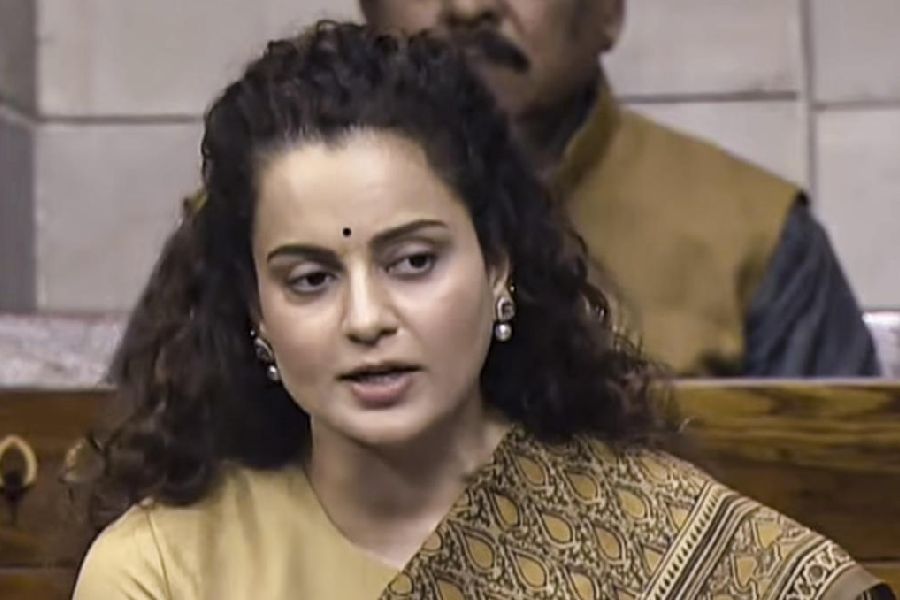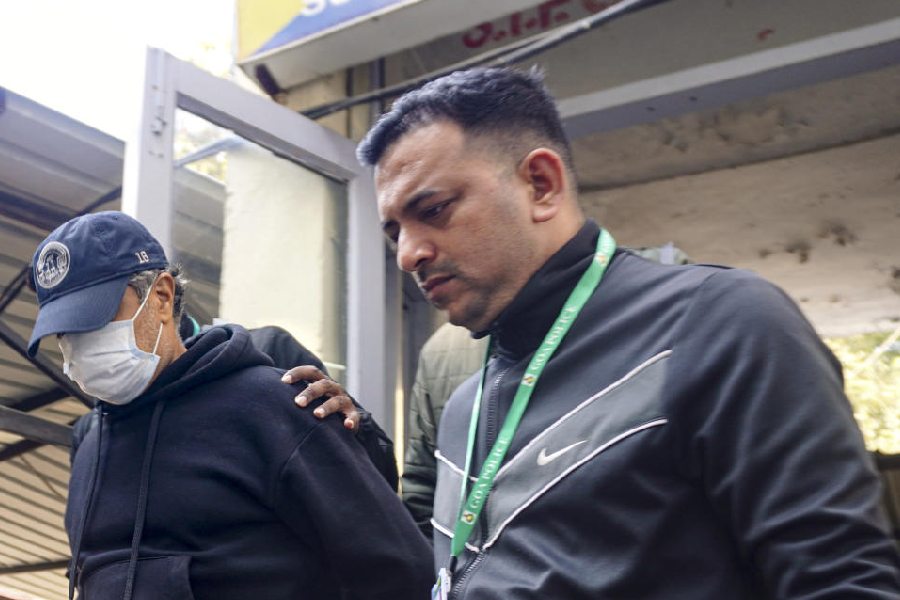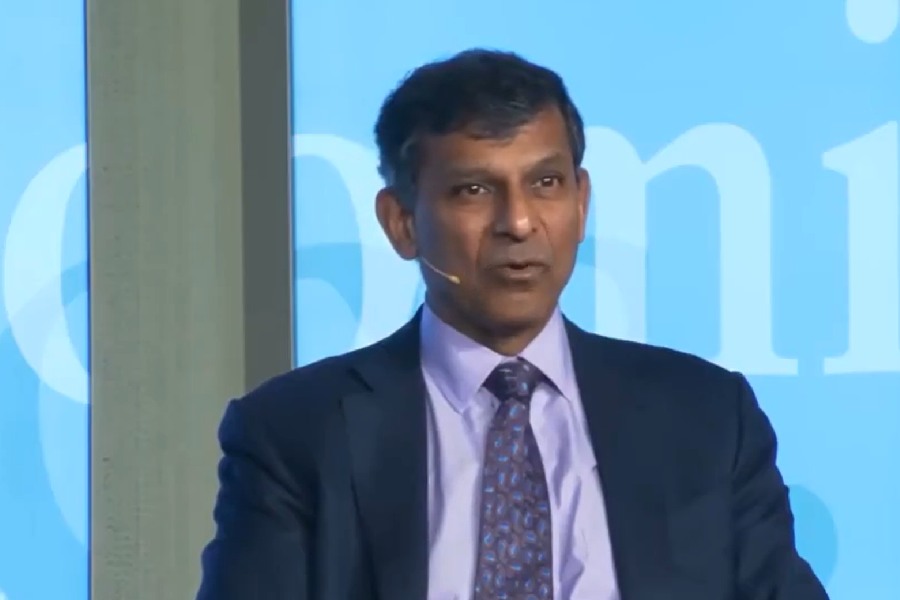 |
| STAGE act: Saoli Mitra (left) in a scene from Chandali staged at Uttam Mancha recently; Academy of Fine Arts (below) |
 |
If you’re at the Academy-Nandan premises, never use the “pay and use” toilet. By the time you’re through, the exit may be blocked by a makeshift stage with a play on in full swing ? or so goes the joke.
Popularly known as Calcutta’s cultural zone, the Academy-Nandan premises is a stretch of land on the A.J.C. Bose Road- Cathedral Road junction. On any weekend evening, the premises can accommodate nearly 5,000 people.
In the mid-1960s, the Academy started drawing the city’s intellectuals. It hit the popularity charts when the stalwarts of Bengali group theatre ? Sambhu Mitra, Utpal Dutt and Ajitesh Bandyopadhyaya ? started performing at the Academy auditorium. The other group theatres joined them, and soon, the Academy became the place for theatre lovers.
That’s still the case. “Today, the only signifier of the avant-garde in the city has become the Academy-Nandan chottor,” points out Suman Mukherjee, the man behind Chetana, the theatre group best known for innovating fresh narration techniques in Bengali theatre, manifest in plays such as Teesta Paarer Brittantva and Gantabya.
One snag: young directors and producers of Bengali group theatre are now looking for alternatives to the Academy. Explains Kaushik Sen, who spearheads Swapnasandhani, a group that experiments in theatre: “The Academy has always been the place for Bengali theatre. But with every passing day, getting a date there is becoming absurd. Even well-established groups do not get enough dates in a year. Unless we are performing regularly, how do we make an impact?” he asks indignantly.
Others too grouse about just this. “Today we are at our tether’s end,” exclaims Saoli Mitra, who leads Pancham Baidic and has landmark performances like in Nathbati Anathbat to her credit. “The Academy, Rabindra Sadan, Girish Mancha and Madhusudan Mancha are the few mainstream halls. The number of shows that you can book annually in these halls can barely sustain meaningful theatre. In a city like Calcutta, there should be an exclusive stage for theatre,” she adds.
Indeed, theatre groups are beginning to steer clear of not just the Academy but other government and commercial halls. Explains Sen: “The established commercial or government halls charge anything between Rs 3,500 and Rs 4,000 for a single show and between Rs 5,500 and Rs 7,000 on weekends. After all this, none of the established city halls allows the groups to enter before 3 pm or stay beyond 9 pm! Backstage conditions are poor. A theatre like Academy doesn’t even have a ‘bar’, which makes stage-setting risky. Girish Mancha, the government theatre, is undergoing renovation after a balcony collapsed recently. At Madhusudan Mancha, water seeps in through the roof when it rains.”
The Academy’s very success has been its undoing. People are not ready to go anywhere else to watch a play, notes Saumitra Basu, the life force of theatre group Sandarbha. Theatre lover Sujata Mitra, 22, backs the point. She believes that theatre is not just about performances but also about ambience. “The Academy-Nandan premises provide an ambience you can soak in to your heart’s content. Besides, you are spoilt for choice. If not a play, you can see a movie. If not an exhibition, maybe you have a seminar. Centrally located and well connected, it makes it easier to meet up with friends and acquaintances too.”
Academy officials are aware of the problem but say that they are helpless. Says former Academy director Colonel (Retd) Ashim Kumar Das: “At the Academy we have evening shows regularly. On Saturdays, Sundays and holidays, we have a matinee show. On Sundays and holidays, we have a morning show, which is allotted on demand. Between September 1 and September 30, we invite applications from theatre groups, asking them to intimate us about the number of shows they’d like to stage next year. Since Academy is the Mecca for all theatre groups, it is impossible for us to meet such overwhelming demands.”
For theatre groups, finding alternative space is tough. Hatibagan in north Calcutta once boasted of a theatre tradition that’s more than a century old. But today most of the halls such as Star, Rangmahal, Visvarupa, Minerva, Bijan are hired by jatra companies or office clubs or to stage magic shows. The alternative then is to stage plays in a few halls in south Calcutta such as Mukta Mancha, Sujata Sadan and Uttam Mancha.
Nonetheless, if a group plans to stage its play seven times a month across the city, the stage space, the entry and exit points, and backstage conditions vary. The only constant factor is the money. And when it comes to technological advancements, there’s little improvement. But in the process of moving to other places in the city, theatre groups are swimming against the widely-held belief that plays should be staged in a central part of the city. And when they stage plays, they have to make efforts to publicise them.
Mukhopadhyay plans to start his theatre in a new space that will be non-proscenium in nature and initiate community participation through door-to-door campaigns using leaflets and posters and by trying to get corporate sponsorships.
Sen has been performing steadfastly at Sujata Sadan, a modest hall, for the last 10 months. Swapnasandhani has fixed the air conditioning system, improved the sound system and upholstered the seats. “All this wouldn’t have been possible without the owner of Sujata Sadan, Samar Mitra’s wholehearted cooperation,” adds Sen. The group is focusing on house-to-house campaigns, school campaigns and poster publicity, apart from offering a quality experience to theatre lovers.
Saoli Mitra has been looking for an alternative space since 2000. Between 2001-2003, she staged regular shows at the Sri Aurobindo Institute of Culture, at the southern end of the city. But with that space no longer available, the group is performing at Uttam Mancha for the time being. She says: “It was a pleasure to rehearse at Anataranga Nat Mancha in Ranikuthi every day, with lights, actual stage space and other theatre specifics.”
Debasis Sengupta, a leading light of theatre group Ethic, has been performing regularly at the Parry Mohan Library in Belghoria for the last four years. Says he: “Through such regular shows it is possible to evolve an independent theatre language by means of which you can communicate with at least a small section of the audience like you do with a friend. They gradually learn to follow your expression and in course, become part of the theatre experience.”
So there’s hope. With so many people joining hands, it shouldn’t be long before the quiet movement gathers enough momentum to create a new, alternative space for Bengali theatre.










